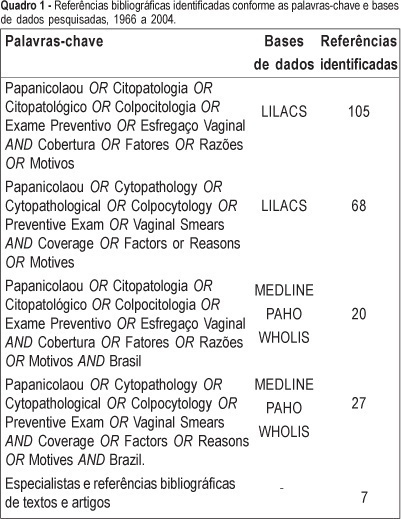You searched for:"Joaquim Gonçalves Valente"
We found (2) results for your search.-
Original Article
Coverage of the Pap smear in Brazil and its determining factors: a systematic literature review
Rev Bras Ginecol Obstet. 2005;27(8):485-492
Summary
Original ArticleCoverage of the Pap smear in Brazil and its determining factors: a systematic literature review
Rev Bras Ginecol Obstet. 2005;27(8):485-492
DOI 10.1590/S0100-72032005000800009
Views0See morePURPOSE: to present an overview of the coverage of the Pap smear in Brazil, emphasizing the determinant factors associated with failure of women to submit to the test. METHODS: the literature was reviewed using the LILACS (Latin-American and Caribbean Literature in Sciences of the Health), MEDLINE – 1966 to 2004 (International Literature in Sciences of the Health), PAHO (Collection of the Library of the Pan-American Organization of Health), and WHOLIS (System of Information of the Library of OMS) databases. The review was enlarged through the search of bibliographical references of relevant studies, request for published and unpublished studies by specialists, and other sources. Articles that fulfilled the following criteria were selected: to be a cross-sectional study, carried out in Brazil, including information about periodicity of the Pap test (some time in life or in the last three years) and/or containing information about factors associated with failure of women to submit to the test. Duplicates and articles without summary were excluded. A total of 13 articles fulfilling these criteria were selected. RESULTS: there are few studies on the coverage of Pap smear in Brazil. Most of them are concentrated in the big cities of the South and Southeast regions of the country. Besides the shortage, little methodological standardization exists in relation to the sampling and profile of the investigated women, which turns difficult the comparison among them. These methodological differences must have contributed to the great variability found in the coverage. However, in spite of all of the problems, a trend of time series increase is observed in the percentage of women who had at least one Pap smear in life. The two studies accomplished in the eighties showed coverage of 55.0 and 68.9% some time in life, while a household survey carried out in 2002 and 2003 presented values that varied from 73.4 to 92.9%; however, two studies of national inclusion presented estimates below 70.0% in the last three years. On the other hand, some variables were associated with the women’s failure to submit to the Pap smear: low socioeconomic level, low education, low family income, and to belong to the younger age groups. CONCLUSION: the data here presented point to regional inequalities in the coverage of the Pap smear in the Brazilian female population and to the need of intervention targeted to those factors associated with women’s failure to submit to the Pap smear.

-
Original Article
Reproductive aspects of climacteric women of the Family Health Program in Cuiabá
Rev Bras Ginecol Obstet. 2002;24(7):441-446
Summary
Original ArticleReproductive aspects of climacteric women of the Family Health Program in Cuiabá
Rev Bras Ginecol Obstet. 2002;24(7):441-446
DOI 10.1590/S0100-72032002000700003
Views2See morePurpose: to evaluate the reproductive aspects in climacteric women of the Family Health Program in Cuiabá. Methods: it was a cross-sectional study including 354 women, with ages between 40 and 65 years, attended at the Central-Western District Family Health Program of Cuiabá. A pretested questionnaire with specific questions regarding the present study was used. Data were analyzed using the Z test and chi² test for trend. The mean age of the 354 women was 49.7±7 years and the median 48 years. A total of 243 (68.6%) were born in Mato Grosso, and the others were migrants from different states. Most were married (65.8%), white (48.0%), catholic (73.4%), and had low schooling: 62.4% did not finish the elementary school and 19.2% were illiterate. About 84% were occupied only in domestic activities, and more than a half (58.2%) belonged to a lower social class. Results: the average number of pregnancies was 5.4±3.3. Nearly 5% were nulliparous and 7% had more than ten children. Almost 50% had the first pregnancy in adolescence and 14% after the age of 40 years. A total of 229 women (65%) were submitted to pelvic surgery: 78% to tubal sterilization, 20% to hysterectomy, and 7% to bilateral oophorectomy. Menopause was due to hysterectomy/oophorectomy in 25% of the women. Conclusion: almost 65% of the women were submitted to a pelvic surgery. The most frequent surgery was tubal sterilization followed by total hysterectomy.
Search
Search in:
Tag Cloud
breast (42) breast cancer (42) breast neoplasms (95) Cesarean section (72) endometriosis (66) infertility (56) Maternal mortality (43) menopause (82) obesity (58) postpartum period (40) pregnancy (225) Pregnancy complications (99) Prenatal care (68) prenatal diagnosis (50) Prevalence (41) Quality of life (51) risk factors (94) ultrasonography (79) urinary incontinence (40) women's health (48)


